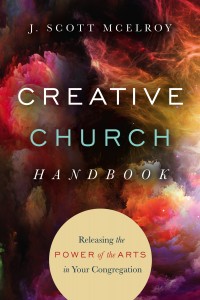 Welcome to the online extras and resources for Chapter 6: Crafting a Creative Arts Community of The Creative Church Handbook. What you’ll find here is material that is helpful and important, but couldn’t be included in the book because of space constraints. Some thoughts include a reference to the specific page they would have appeared on.
Welcome to the online extras and resources for Chapter 6: Crafting a Creative Arts Community of The Creative Church Handbook. What you’ll find here is material that is helpful and important, but couldn’t be included in the book because of space constraints. Some thoughts include a reference to the specific page they would have appeared on.
For information and discussion on similar topics see The New Renaissance Arts Movement site at TheNewR.org. For questions, comments, or use permissions you may contact the author directly at Scott (at) TheNewR.org.
Visit our CreativeChurchArtsIdeas.org website for more ideas for creativity and arts ministry in the local church!
The page is under construction. Please check back for updates!
Chapter 6: Crafting a Creative Arts Community
Sometimes when artists meet in community it can be fun to do a group exercise. Below is a unique one (click to download):
Below is a sample of a sheet the Bethel Church arts ministry uses to record art testimonies. This one was distributed at their 2014 School of Creativity (click to download):
Testimonies are greatly valued throughout the Bethel Church culture. They expect to see God moving in people’s lives on a regular basis, so they love to talk about what is happening as he connects with people through the arts. Not only are testimonies included in the weekly meetings, but once a month they’ll devote most of a meeting to them.
Book studies. There are many books on the arts to study together that will
benefit your community, giving them a shared experience and getting everyone
on the same page. See the online resources REFER TO CHAPTER 4.
Thoughts from Cindy (West) Limbrick of Woodman Valley Chapel:
Cindy Limbrick talks about some of the early meetings of the Imago Dei arts group at Woodman Valley Chapel: “Those meetings, especially when we first started, were just powerful because of the creative projects we would do. I took fruit in one day, tons of different kinds of fruit and toothpicks and string and they thought they were going to photograph or draw these things. Instead, we created something from the fruit. And I’m telling you, it was just fun, it was messy, but it was unbelievable what these people came up with; cucumbers that turned into palm trees, and all this crazy stuff, but it was just getting them out of their box into different kinds of creativity.”
More thoughts on eating together as a community:
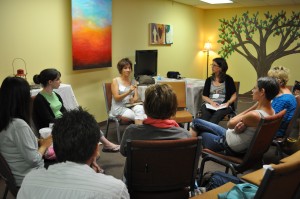
discussion on live painting in the church.
Photo: JSM
Psychologists report that children are better adjusted socially and emotionally when they eat with their families on a regular basis and are less likely to be depressed or use drugs. And science has shown eating together strengthens community. Anthropologists have found that the rituals surrounding eating bind people to their shared identity through powerful links between food and memory.
Thoughts from The Grove:
Roy Cochran, who leads The Grove artist gatherings recounts what a typical Grove gathering might look like:
“People will show up at 6:30pm and are greeted by a personable communicator who asks if you want to just be a guest or want to be invited next month. If you want to come back, then you give your contact info. People are invited to contribute $5-10 to help pay for the meal and drinks, which is not like a cover charge, but an invitation to be generous, one of the Grove’s values.
You walk in to the living room/ kitchen area and dinner is being prepared by a chef who donates his time. You get a name tag and then grab a plate and a drink (they do serve wine) and if you don’t know anybody, someone will probably come up and start talking to you. Before long there are 50 people in this medium-sized house and it is buzzing. Chairs are set up randomly and after about an hour of eating and socializing, I’ll invite a musical artist to share an original song or two and lead in some worship tunes for 20 minutes or so. You are kind of invited into the living room area for this. Then the musician may share a little of their heart. Recently a musician shared a song about his battle with depression and talked about it for a few minutes. That really struck a cord with people, many whom are afraid to tell anyone that they struggle with this.
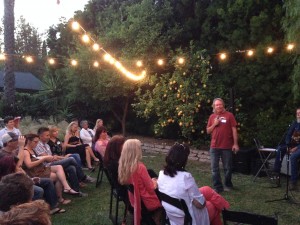
gathering with Grove Center for the Arts and
Media in Orange County, CA.
Photo: Joey O’Connor.
Then I share our values as a community and how we want to see spiritual and creative cultivation in artists.” (The Grove uses idea of cultivation because they own and operate an avocado farm.)
At a recent gathering Grove founder Joey O’Connor shared a bit about a book he was reading. Then they passed around a little outline of what the book dealt with and related that to personal dreams the artists have. This started a great discussion and several people shared dreams and ideas in the larger group. Then they broke into groups of 4 to 5 people and talked more about these ideas. This went on for a half an hour.
“They begin praying for another and some are getting breakthrough prayer. Some are having profound experiences because they are being heard and cared for.”
As groups finish up they head into the kitchen and get some dessert. It’s about 9:30 by then and people who have kids and need to leave migrate out. When we have some crop from our 16 acres we’ll bring in some fresh fruit–avocados or lemons–and let people take bags home. Others stay until midnight, and the music may start up again, another bottle of wine may be opened or some people may find a quiet place to pray or talk some more.”
Thoughts from Ann Williams of Visual Voice:
Ann talks about the importance of community in their ministry:
Several years ago we were doing many different art programs and were spread pretty thin. Our team started to feel that God was calling us to just build community with the artists, so we kind of stopped doing everything but classes and galleries. We began to
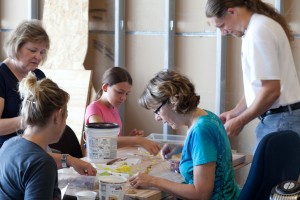
Lincoln Berean Church work together on a
mosaic project. Photo: Jennie Prescott.
watch so many different people just grow in their walk with God, how they do art and how they think about art.
One group was working on art related to the theme ‘Redeemed’ and we talked about how God was doing this in individual stories, but also in areas of life all around us which expanded our understanding of what redemption is. Before the group left, each person was asked to write his/her name on a piece of paper and include contact information. Then each person randomly selected a piece of paper which contained the name of someone in the group. The artist’s job is then to call that one person throughout the course of the project and encourage them in some way. The artists are challenged to listen to the Spirit as to how He would direct them in prayer for, to call, and/or encourage that person. We’ve done this several times and it has been awesome to watch people connect to one another through these interactions.
They also encountered the disagreements and difficulties that go with creating as a team. Each group had to learn to compromise for the sake of the work and also openly communicate with one another.

The conflict resolution can really build a community closer if done the right way and hearts are open.
Describing how the gallery team works: The team lays the show out together, learning to give and take and sharing their preferences in placement of the work. Working side by side gives them insight into each others personalities. Through the building of friendship during service, team members can then support one another during life’s circumstances and bumpy roads. Pg 114
We have started going to conferences together and an occasional retreat. Of course any time you put people in a car or on a plane and make them traveling companions, they learn about one another. Then once or twice a year, the team comes over for dinner and conversation, no business just being together. Pg 114
We’ve also met together around a book study. Working through a study has brought us closer together as we are challenged to be vulnerable and share the areas of our lives that are easier to hide while we do the work of ministry.
The more committed each individual is to seeking Christ and the Kingdom of God, and seeking to work together to “present every person complete in Christ,” (the mission statement of Lincoln Berean Church) the deeper we’ve witnessed relationships and community become.
In the summer our photography group will meet every other week and photograph at a preplanned location. Other times of the year there might be informal, spontaneous gatherings where members of the group go and photograph an area of town. One or two people “host” and they invite others via word of mouth and on the group’s Flickr site.
Thoughts from Tina Colon Williams of Elm City Artists Circle:
Several years ago, a friend and I sat in a coffee shop talking about art. Both of us were worship leaders in our church. She wrote poems and painted with watercolors. I wrote songs. We had been creating alone and sporadically, without much vision or connection with others besides ourselves. As we talked, we realized that something was missing in our community—we of many creative people, some for whom art was their profession, but almost all of them created alone. That realization revealed a lacking that we had not previously noticed: the need for an intentional, transformative space for artists to create in community.
So we created the Elm City Artist’s Circle. As we began meeting together, we started noticing a few pervasive and unmet needs that many artists confront in their pursuit of creativity. One was community. For most people, art is an individual pursuit, and the processes and products of artistic creation are distinctly personal—as a result, far too much art is never seen or enjoyed by others. Another was vulnerability. Fear prevents too many of us from pursuing creativity and then failing to share what we create. We convince ourselves that we are not real artists, that we are not good enough. The vulnerability that comes from purposefully sharing our imperfect creations in community is one way to undermine that kind of paralyzing fear, yet those sorts of safe spaces are hard to find. And lastly, discipline. Few of us have others in our lives who cause us to create or who force us to carve out time in our schedules for creative work. Things like deadlines and creative routines are so important, but all too often artists lack these kinds of disciplines. Pg 116 (This originally appeared in CIVA’s Seen Journal)
Thoughts from Marianne Lettieri of Arts of the Covenant:
AOC originally focused on a “show and tell” time every month, where artists would bring their work and talk about it, but as the meetings got bigger it became impossible to do anything else after everyone shared. Now they offer a monthly art critique right before the general meeting for anyone who is interested, and they devote a full meeting once a year to just sharing their art and talking about it.
Occasionally they integrate a hands-on activity into the evening’s program that supports artists’ kinetic mode of learning and information processing. Sometimes it is a creative exercise that helps members meditate on scripture while using art materials.
“People might make a collage, work with a lump of clay, or craft a small mosaic, not to learn a technique or medium and make a great piece, but to better understand the intersection of art and faith or internalize the word of God,” Marianne says. Pg 121
They also work with arts leaders from other churches. They’ve made an effort to present programs that can help church creative leaders learn from each other, connect, and share ideas.
“Often artists contact us and say, ‘We want to start an arts community at our church, or we want to do an exhibit at our church.’ So we’ll meet with them and lend a hand. That is what’s exciting to us. It’s not how big can we make Arts of the Covenant, but how many other Christian art ministries can we help launch and support.”
One of the things they do to encourage arts ministries is something they call the “Raging Bull Award” that was inspired by a video produced by cultural commentator Craig Detweiler. In the video, Dr. Detweiler says that the church is full of raging bulls, artists, eager to be set free. The job of the arts pastor is to unleash the talent sitting in the pews. So AOC created the “Raging Bull Award” that recognizes individual members who have worked to integrate the visual arts into the life of their churches and their communities. “The recipient is given a certificate and the honor of wearing bull horns. People really want that award! The “wearing of the horns” has become an exciting moment in our meetings.”
When artists who haven’t connected their faith and art before finally do, they have a new dialogue with God because they are making art for him.
Thoughts from Cyndee Buck of Express Your Faith:
Cyndee talks about some unique components of their arts ministry:
“Our prayer shawl ministry gets together every Monday and knits and prays over these prayer shawls, then gives them to people the church has identified as having needs. It saturates them in prayer. The scrap bookers have sort of an open studio for people to get together and just create. Every month their group will start at 8 am on a Friday and go until 11 at night. The next morning they’re back at 8:30 am and they go till 3 in the afternoon. They are serious!”
Matt Tommey of The Worship Studio talks about crafting a success creative community:
I would say don’t over program it. In the church especially people have a tendency to program the heck out of things and it becomes this little shtick that people decide if they want to participate in or not, as opposed to just getting together with the expectation to love people and hear each other. To me that’s what creative people are looking for: someplace where I can be heard, where I can be understood, where I can be affirmed. When that’s the goal, whether it takes the form of a book study or whatever, people are going to come to that.
We’ve been doing a group since I moved to Asheville, NC 4 years ago, and we’ll have anywhere from 16 to 40 people depending on what we’re doing on those evenings. But the core is the same. I tell people if you can love people you can start a creative community. Essentially what it is is creating a safe place where creative people can begin to be in relationship and talk about what it means to be creative in their personal faith. I think when you do more than that, not that you can’t plan, but when it gets so programmed then it becomes about what you are doing verses the life that you are sharing together. We try to ere on the other side of that.
Thoughts from Nick Benoit of Rock Harbor and Willow Creek:
One of the things that I love about Rock Harbor, is that every artist who came to our church, we understood that person is bringing something really unique to the mix. We weren’t just trying to plug them into a specific place but we tried to have conversations with them asking, “What do you uniquely bring to the table”. And every person who comes to the table, changes what is possible. And so we were always looking for ways to innovate but not for the sake of innovation, but for the sake of, seeing people realize their full potential as artists in Christ.
If artists only hang out with artists they can become sort of ghettoized.
Meanings the Mosaic Church LA statues (thoughts from David Arcos):
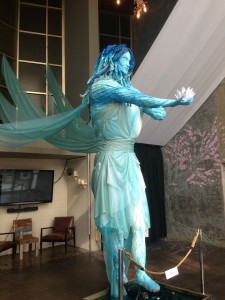
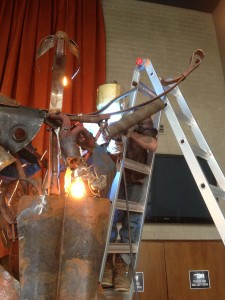
These are some of 5 statues based around Mosaics core values. Each value has a metaphor, so we built these statues using these metaphors with virtually no budget. Just sweat, passion and imagination!
The ethos of Mosaic is built on the stories that create the art.
These projects created us we didn’t just create them. Some of them are 12 ft tall. They stood in our church lobby during our sermon series on the church’s core values.
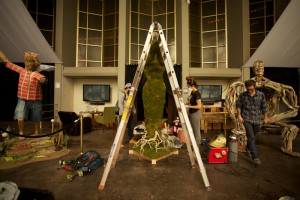
Fire giant : Ariel and Oti Verges
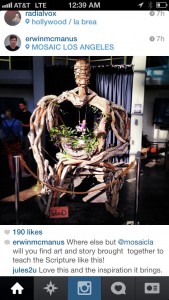
Relevance to culture is not optional. When we have the fire of God inside of us we engage culture in a new and vibrant way.
Wood Giant : David Arcos
Wood–structure– must always submit to spirit. The girl swinging inside his chest is the spirit. The body is his structure.
Water giant : Patrick Diaz
Water is unstoppable like love. Love is the context of all mission. Our love for people validates our relationship with God.
Saddleback Visual Arts (formerly Ex Creatis) meeting details–Studio Collective and Open Create:
Saddleback Visual Arts (formerly Ex Creatis) arts ministry at Saddleback Church meets weekly. Here is what their meetings might look like:
DISCUSSION | 7pm-8pm
Group discussions with a basis ranging from books, to individual artists and artworks, film clips, or topics related to artistic and spiritual growth. Come at 7pm sharp to be part of the conversation.
COLLECTIVE | 8pm-10pm
Weekly group effort to work collectively in one of two ways: exhale is directed outward toserve our community through art, while inhale is directed inward to learn and gain inspiration.
Collective exhale
– Making art purposed to serve the community
– Creating framework for interactive art pieces
– Ideating community-oriented art projects
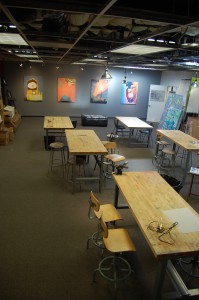
Collective inhale**
-Inspiration from an artist or presenter
-Learning through workshops
** Every 1st Thursday of the month will be a Collective inhale (8pm-10pm) POTLUCK + Documentary + Discussion. Bring a dish to share, enjoy the film, and talk through is as a group afterward.
OPEN CREATE | 10pm-12am
An unstructured time for you to simply work on your individual projects amongst the community of artists here. Basic tools provided for your use, free of charge. Art forms range from fine art, to writing, to music, to graphic design, and more.
ADDITIONAL OPEN CREATE HOURS
Sun-Wed: Closed
Thu: See Schedule*
Fri: 1pm-6pm
Sat: 1pm-6pm
Sherri Coffield of EnVision:
Our team is delighted to minister to creatives we’ve never met before. The fruit is seeing artists being healed from their brokenness and then taking God’s message of faith and creativity into their own spheres of influence. Even some area pastors are starting to attend. We sometimes mention at our Envision meetings that our goal is not to steal artists away from other churches, but the opposite: We see ourselves as children splashing in a glorious puddle and broadcasting the droplets to places nearby. Over one third of our attendees come from other churches and we see them leaving encouraged and uplifted every time, secure in the
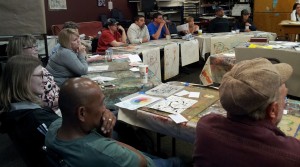
knowledge of Whose they are and affirmed in their creative talents.
Our team created a code of grace that we summarize or read at most Envision meetings, which acknowledges that we all come from a variety of religious and traditional backgrounds and our goal is to inspire one another through these different approaches, rather than to argue over denominational differences (which we’ve never seen happen, by the way, maybe because we state it preemptively). We firmly uphold our unity under the Lordship of Christ. We embrace the beauty that is found in a wide variety of worship and engagement styles from different historical and liturgical traditions, and we examine contemporary interpretations in Christian artistic expression, first theologically, then experientially. God’s brilliance is infinite, and his truth and beauty transcend style every time.
Sherri reconfigures the room for each Envision meeting, providing different environments for the purpose that she imagines for that evening. Whiteboards turn into canvas-draped art displays and chairs may be in unusual formations such as in a circle surrounding a campfire in the middle of the floor – unlit, of course!
Thoughts from Jessie Nilo:
Our team prays together while we’re working or serving or teaching or talking or setting up drop cloths, or whatever. Even if you’re a task-oriented ministry, you should pray for each others needs at the drop of a hat. Model it for your team.
Help the church play. And as your group gels you can facilitate play with art in your congregation and church. You might be able to create an environment in which 10 or 15 years from now, platoons of artists will credit your church for their foundational beginnings in art. Allow amateurs, non-artists, and kids to participate in at least some (preferably most) congregational art venues, asking people which workshop and learning opportunities they crave. This is part of building a creative church. You might ask, “But won’t
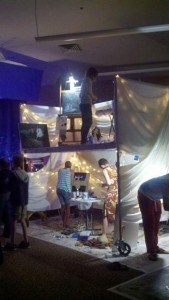
all this freedom compromise the level of excellence of art in our church?” Jessie Nilo says, “You needn’t worry. You will hand-select the best artists for certain venues, i.e. public installations, special invitation exhibits, liturgical art, sanctuary art, or prophetic painting onstage, because excellence does glorify God. But in the studio, workshops, and book studies, resist elitism; in the gallery, consider a location to display beginner’s artwork. Closed-off cliques of professionals can result in task burnout and stunted, in-grown character. Exclusivity will frustrate and discourage the creative spirit at your church. If your non-artists discover their creativity while your amateur artists grow artistically, in a few short years you’ll have an army of artists whose level of artistic excellence will astonish you. Not to mention a generation of kids who know with certainty that art in church is normal.” Pg 106
We went for a long time, over a year of just building relationships and hanging out before we asked our artists to contribute their
work to projects or events at the church. Then it just happened naturally as people became comfortable in the community and opportunities presented themselves. We wanted it to be clear that the community was a safe place and that relationship and personal growth is more important than completing a bunch of projects.
Our leadership team reserves the third Sunday of every month for meetings right after church over lunch, and it’s on all of our calendars. We established our third Sunday tradition years ago. Pg 109
Sometimes we even set a timer when it comes to the sharing of ideas or reports, and have fun with keeping everyone on track. Also on the agenda maybe twice a year is a time to pray together about the titles of upcoming gallery exhibits, or the theme of an upcoming congregational study initiated by the pastors. We usually illuminate those sermon series on our sanctuary backdrop
Sometimes our meetings are just a quick get together with lunch and no agenda. Often it’s in the form of taking a sketch outing together or visiting one of our members as they exhibit somewhere nearby, or just a small conversational gathering. Pg 110. In that case there is not much of an agenda, other than to get a feel for how everyone is doing. Usually we find that the focus of that gathering will fall on one or two of our team members who need prayer, encouragement, and unconditional love. The recipient of this soaking prayer generally feels overwhelmed by love. I have received this type of prayer numerous times from my team, and it’s been a highlight of my personal ministry experience.
Of course, God often hijacks my own plans and agendas when I do set them, so I am very open to his changes in direction. My team is the same. We model to each other the kind of openhanded giving and receiving that we imagine God wants us to embrace as artists in his kingdom.
Persevere. Be gracious whenever you’re told “no.” Leave the church facility more sparkling than how you found it. Use dropcloths and tape the edges with appropriate, non-residual tape so nobody trips and sues your church. Be faithful and patient. Educate your art team on how to communicate with the staff. Eventually your leaders will relax and be won over by the beauty of what you’re doing. It took us a few years, but I know our staff would shudder now at the thought of an artless church.
Artists everywhere need community. Exceptionally attuned to life, artists are compelled to explore what it means to be human, a task difficult to do in isolation and hazardous to do without a solid spiritual foundation. God created us to process life together, to develop our gifts, encourage one another, and influence the world around us. Artists yearn so deeply for community; even wounded and insecure artists are desperate to know they are not alone in their fears. We’re created to need each other. We just need a place to meet.
If artists can their let guard down, seek healing and growth together, and shape and live out their values together, they become a stronger community.
As they grow into creative leaders and lead the congregation into releasing their own creativity through arts ministry, the artist support community will continue to play an important role.
Thoughts from Lisa Marten of VineArts:
We have a heart to see artists’ hearts set free…and so this sometimes requires helping people to lay down their fears & insecurities so they allow themselves to make mistakes and have fun. One of the hardest things we encounter is the artist who says “i can’t”…or “i’m not an artist”. We know that God has work to do.
People have hurts and pains, fears and insecurities from their past (and artists tend to wrap all those things up around their view of who they are as an artist and as a person). There may be need for forgiveness and healing in order for someone to truly embrace being an artist in this world and being a worshipping artist co-creating with God. It may take one on one deep conversations and prayer. Ultimately, what we do as an art ministry…it’s about seeing people’s hearts set free in Christ.
